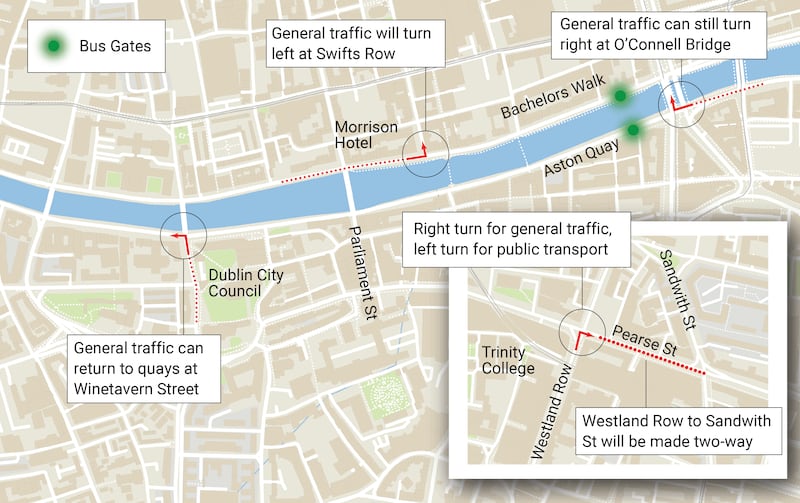Behind the counter in The Sweetest Thing cafe on Bachelors Walk, staff were discussing the major changes planned for traffic moving up Dublin city centre’s north quay, as cars and buses streamed steadily by outside during rush hour.
Later this year, cars and lorries will no longer be able to continue past the small cafe on to O’Connell Street or towards the Custom House under a new Dublin City Council (DCC) traffic plan. The restriction will be one of several changes – starting from August – aimed at curtailing the number of people driving through Dublin city, by limiting private car access to several streets.
Catherine Byrne, owner of The Sweetest Thing, says the flow of traffic passing the cafe each day was often not a bad thing. “A lot of our customers come in and say, ‘Oh I used to drive by and always wanted to visit, and then I’m in town today and came in’,” she says.
“We have a lot of trouble here at night, once it’s dark in the winter; when there is a lot of traffic going past you feel kind of safe,” Byrne says. “There was a guy thrown out in front of a bus there last Monday, two guys were chasing him. That happened but there was a lot of traffic stopping, people getting out of cars to see if he was okay; whereas if there’s no traffic any more, you feel more isolated,” she says.
READ MORE
Byrne, who has run the cafe for 10 years, says the proposals would also have benefits, such as bringing “a lot more footfall” to the area.
Over on Parliament Street, which will be pedestrianised in 2025 under the plans, Siobhan Conmy says the move to ban cars on the street was a “brilliant” idea.
Conmy, owner of Street 66, one of the bars on the street, says being able to provide outdoor seating similar to that on Capel Street would be a boost for businesses. “I think it is going to be gorgeous, because we’ve City Hall as the backdrop, it’s a beautiful street… I’m really looking forward to it,” she says.

Street 66 previously had a section of outdoor seating on the street during the Covid-19 pandemic, which Conmy says created a lovely atmosphere, before DCC controversially replaced it with a bike rack. “During Covid it was fantastic, the vibe was really nice on the street,” she says.
“At the moment there’s literally one car passing every three minutes – it’s not even that busy,” Conmy says. “Most of the businesses on the street are hospitality. So I think it’s going to be really good for the whole street.”
We don’t get the impression that a lot of people are coming into town, parking and coming in to us. We get a lot of students, a lot of people who seem to be pedestrians…
— Louisa Earls, Books Upstairs
The other significant traffic changes would see access down Aston Quay limited to buses and taxis, private cars prevented from turning left from Westland Row on to Pearse Street, and the creation of “civic plazas” at College Green, the Custom House and Lincoln Place.
[ The Irish Times view on the pedestrianisation of Dublin: cars don’t stop riotsOpens in new window ]
For Slawek Dubaj, the council’s efforts to reduce the number of motorists driving through the city centre would mean a safer cycle to work each morning.
Originally from Poland, Dubaj has lived in Ireland for the last two decades and currently works at Unique crafts shop at George’s Street Arcade.

At the moment the amount of traffic on the roads can make his cycle between Ashtown and the city centre “overwhelming”, he says. On a rainy day, when more people take the car, the journey can be particularly dangerous for cyclists, he adds.
“The less traffic, it is safer to travel… The less lanes for the cars means more lanes for cyclists, so that is handy for me from my perspective,” he says.
Louisa Earls, manager of Books Upstairs on D’Olier Street, says the normal clientele of the family-run bookshop was often people who had not driven into the city centre.
[ Dublin pedestrianisation plans to be reassessed following city riotsOpens in new window ]
“We don’t get the impression that a lot of people are coming into town, parking and coming in to us. We get a lot of students, a lot of people who seem to be pedestrians… They are people who made their way into town some other way – public transport, cycling,” she says.
The shop benefited from people popping in for a few minutes as they waited at the row of bus stops on the street, she says. While it was important that public transport links were not cut back, Earls says she would be supportive of measures to stop cars “barrelling through the city centre”.
- Sign up for push alerts and have the best news, analysis and comment delivered directly to your phone
- Find The Irish Times on WhatsApp and stay up to date
- Our In The News podcast is now published daily – Find the latest episode here

















